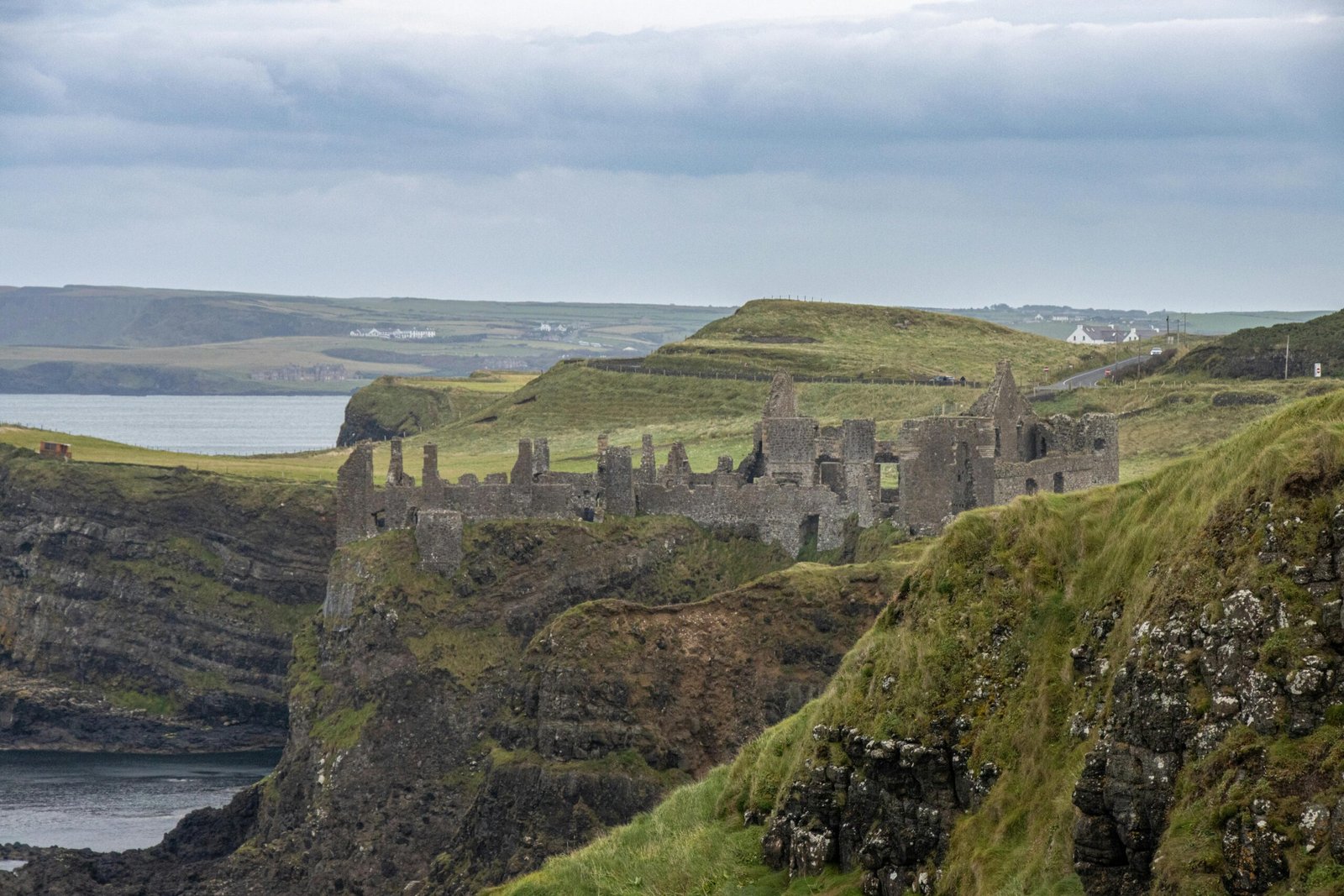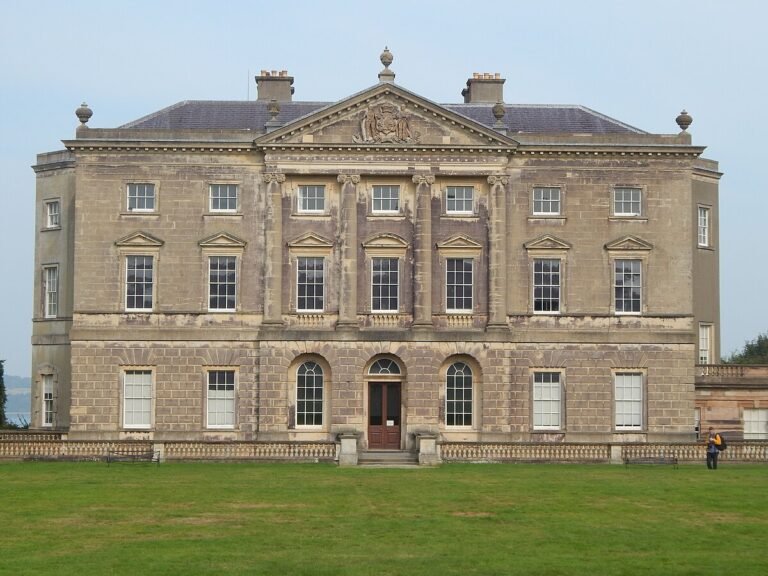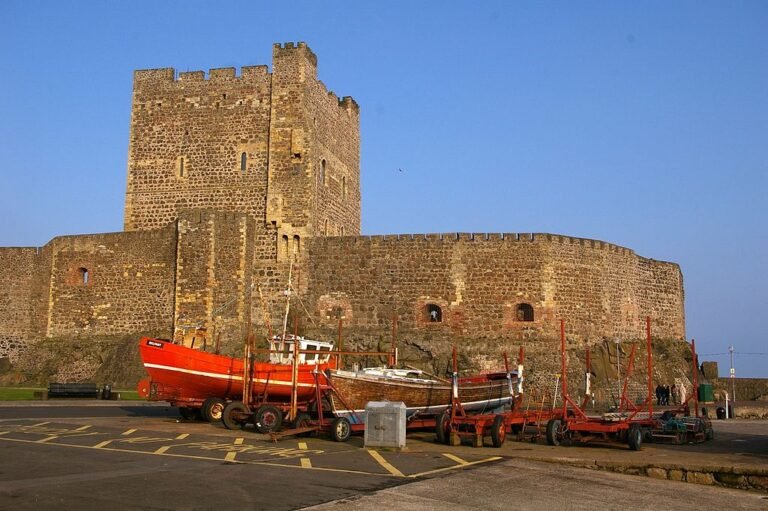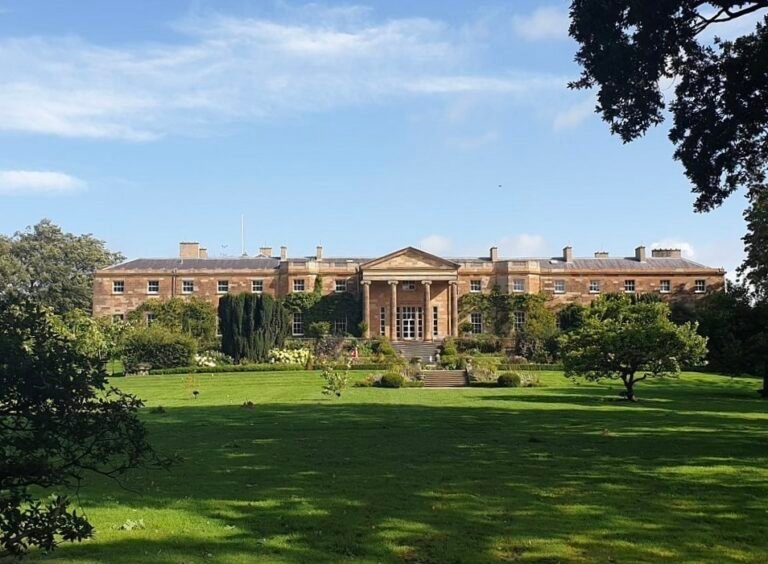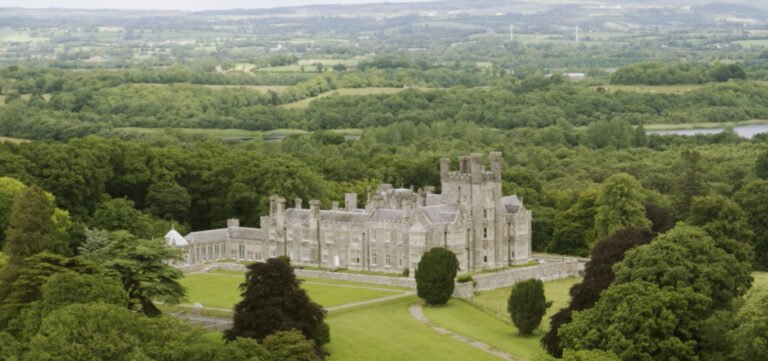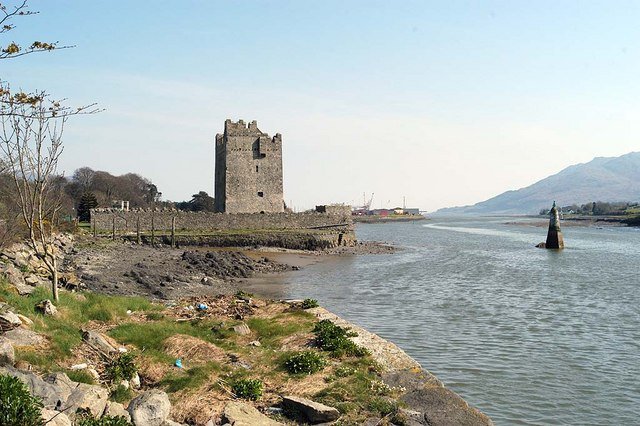Dunluce Castle: A Cliff‑Edge Sentinel of Turbulence and Romance
Dunluce Castle is more than just weathered stone; it’s a dramatic tapestry woven from medieval ambition, coastal storms, clan intrigue, and enduring myth. Perched on a basalt outcrop between Portballintrae and Portrush, this ruined fortress commands the North Atlantic with an atmosphere as charged as its past.
Dunluce Castle: Historical Origins – From Fortress to MacDonnell Stronghold
The earliest known castle at this site dates back to the 13th century, attributable to Richard Óg de Burgh, 2nd Earl of Ulster, possibly built atop older Irish or even Viking fortifications. By 1513, the McQuillan clan, Lords of the Route, held and significantly fortified the castle, adding formidable drum towers and curtain walls.
In the mid‑1500s, the ambitious MacDonnell clan wrested control from their rivals. Sorley Boy MacDonnell reimagined the castle’s character with Scottish-style reinforcements and grandiose enhancements. When a galleass from the Spanish Armada, the Girona, wrecked nearby in 1588, the MacDonnells salvaged its cannons and cargo, using the proceeds to restore and elevate the castle’s prestige.
By the 17th century, Dunluce had become the seat of the Earls of Antrim. Randal McDonnell, the 1st Earl, adorned the castle with lavish furnishings via his duchess wife, Katherine Villiers. However, their fortunes waned after the Battle of the Boyne (1690), and the once-magnificent edifice was abandoned, succumbing to neglect and stone robbery.
Dunluce Castle: Ghosts, Legends & the “White Lady”
Clinging to its cliff-edge perch, Dunluce inspires both awe and superstition. Local lore tells of a tragic McQuillan maiden, the so-called “White Lady”, who pined away in the northeast tower, her anguished spirit said to haunt the ruins.
The castle’s partial collapse, especially the story of the kitchen plunging into the sea during a fierce storm, adds to its dramatic allure, echoing themes of vulnerability and fate.
Rediscovering Dunluce Town: A 17th‑Century First
It’s not just the castle that captivates the adjacent, long-lost Dunluce Town, founded around 1608 by Randal McDonnell, which has emerged from archaeological obscurity. Unearthed in 2011, this settlement reveals a grid‑plan layout and even early indoor toilets remarkably advanced for pre‑Plantation Ulster. Yet, much of this town remains buried beneath centuries of ruins.
Visiting Today: Practical Magic
Opening Hours & Admission
- Winter (18 Nov 2024 – 16 Feb 2025): 9 am – 4 pm
- Summer (17 Feb 2025 – 16 Nov 2025): 9:30 am – 5 pm
- Last admission: 30 minutes before closing
Ticket prices generally hover around:
- Adult: £6
- Child (5–17): £4
- Concession: £4.50
- Family: ~£18
Facilities & Access
Visitors cross a narrow footbridge where a drawbridge once stood, to explore guided or self-guided tours (with multilingual headsets), archaeology exhibits, a gift shop, and a café just beyond the car park. Accessibility is limited due to uneven terrain, though there are designated viewing areas.
Getting There
- From Belfast: approximately 50 miles (road distance ~60 miles). Many tours especially those that include the Giant’s Causeway or Game of Thrones sites, stop at Dunluce.
- Parking is available; no advance booking is required, though severe weather may affect opening times.
Suggested Visit Duration
Allocate at least 60 minutes to 1.5 hour to explore both castle and town remains comfortably.
Sample Itineraries
1‑Day Coastal Highlights
- Morning: Depart Belfast for Dunluce. Explore the castle and visitor exhibits for over 1–1.5 hours.
- Midday: Grab lunch in nearby Bushmills or bring a picnic to enjoy at Magheracross Viewing Point.
- Afternoon: Continue to the Giant’s Causeway or Royal Portrush (perhaps walk the famed Dunluce Links, named after the castle).
- Evening: Return to Belfast or stay in coastal accommodation.
Region & Heritage Loop (2–3 Days)
Day 1: Belfast → Dunluce Castle → Giant’s Causeway → stay in Bushmills or Portrush.
Day 2: Tour the Causeway Coast (Carrick-a-Rede Rope Bridge, Ballintoy Harbour), and swing by the dramatic Royal Portrush Golf Club.
Day 3: Venture inland to explore Glenarm Castle and the Glens of Antrim.
Where to Stay & Eat
- Near Dunluce: Charming B&Bs and small hotels in Bushmills or Portballintrae offer coastal views and easy access.
- Mid‑range Options: Portrush offers seaside lodging and a closer proximity to amenities and nightlife.
- Boutique Picks: Consider a cottage or styled inn along the Causeway Coast for a cosy, romantic stay.
- Dining Suggestions: Family‑friendly cafés and pubs in Bushmills; local fare such as hearty Irish stew, fresh seafood, and artisan baking.
Why Dunluce Inspires (and Endures)
- Historical Significance: From Norman roots to clan clashes and the Spanish Armada, this castle stands at the crossroads of key chapters in Ulster’s lore.
- Visual Drama: Its precipitous perch and ruins make for photographable moments and evoke a sense of timeless wonder.
- Cultural Impact: Believed to have inspired Cair Paravel in The Chronicles of Narnia and featured in Game of Thrones as Pyke.
- Archaeological Richness: The rediscovery of Dunluce Town offers a rare window into early 17th-century urban planning and domestic comfort.
Broader UK Travel Threads
Dunluce is a microcosm of themes that ripple across UK travel:
- Heritage Tourism: Castles like Dunluce connect with others across Britain, think Tintagel, Eilean Donan, or Stirling.
- Film vs Reality: From Game of Thrones to cinematic inspirations, such sites bridge the gap between fiction and landscape.
- Rail & Road Adventures: The Causeway Coast is part of scenic routes inviting road-trippers to travel greenways and coastal panoramas.
- Culture–Food Trails: Blend your visit with local whiskey distilleries or seafood markets to taste the region’s personality.
Final Thoughts
Dunluce Castle stands not just as a relic of stone, but as a living chronicle of ambition, beauty, tragedy and renewal. Whether you’re a family seeking dramatic adventure, a couple chasing romance in forgotten halls, or a solo traveller drawn by stories etched in cliff faces, Dunluce breathes life into history with every wave that bangs beneath its foundations.
Frequently Asked Questions – Dunluce Castle
Where is Dunluce Castle located?
Dunluce Castle sits dramatically on a basalt outcrop along the Causeway Coast in County Antrim, Northern Ireland, between Portballintrae and Portrush, and is connected to the mainland by a narrow bridge.
Who built Dunluce Castle and when?
The earliest fortification was attributed to Richard Óg de Burgh, 2nd Earl of Ulster, in the 13th century. However, the castle ruins visible today were built by the McQuillan clan around 1513 and later captured and expanded by the MacDonnell clan in the mid-1500s.
Why was Dunluce Castle abandoned?
Multiple factors contributed: a dramatic collapse of the kitchen into the sea in 1639, a destructive fire in the nearby town around 1642, erosion from its precarious cliff location, and the decline in the MacDonnells’ fortunes following the Battle of the Boyne in 1690.
What was the “lost town” of Dunluce?
Established around 1608 by Randal MacDonnell, the town once featured a sophisticated grid layout, streets and even indoor toilets, innovative for its time. Much of it was abandoned and has since become partially buried, though excavation in 2011 revealed its layout.
Is Dunluce Castle in Game of Thrones or Narnia?
While the castle itself wasn’t a filming location for Game of Thrones, its appearance was digitally used as inspiration for Castle Greyjoy (Pyke). It’s also believed to have inspired C.S. Lewis’s Cair Paravel in The Chronicles of Narnia.
Is Dunluce Castle open to visitors? What are the hours and admission costs?
Yes. Tickets are purchased on-site; online booking isn’t available. Admission (as of early 2025) is approximately: Adult £6, Child (5–17) £4, Concession £4.50, Family ~£18. Opening hours typically run from 09:30 to 17:00 (16:00 in winter), with last entry around 16:30.
What facilities are available, and how accessible is it?
The visitor centre includes a small café (Wee Café), exhibits, a gift shop, and multimedia guides. Due to the cliff-top terrain, accessibility is limited; wheelchair access is minimal, but there are viewing areas and some facilities nearby (e.g., Magheracross Lookout).
How do I get to Dunluce Castle, and where can I park?
Driving is most convenient, with a small car park onsite and additional spaces at Magheracross (a short walk away). Alternatively, public transport requires a transfer via Coleraine or Bushmills, and there are many tour options from Belfast that include Dunluce.
What are some notable nearby attractions?
Nearby highlights include the UNESCO-listed Giant’s Causeway, Carrick-a-Rede Rope Bridge, the Old Bushmills Distillery, Ballintoy Harbour, Dark Hedges, and scenic walks along the Causeway Coast.
